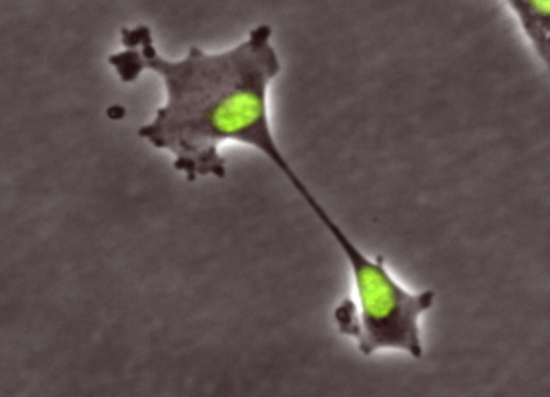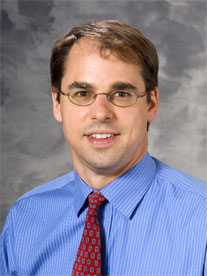9 K* S2 F. m' v% G! l2 h" h! m# F
: [# C: g$ p5 ~: a# Y+ ^据物理学家组织网12月18日(北京时间)报道,美国威斯康辛大学卡邦癌症中心发现了一种人类细胞分裂的新形式,并称之为“核分裂”(klerokinesis)。这种新分裂形式是一种对错误细胞分裂的天然补救机制,能预防某些细胞步入“癌”途。他们在12月17日于旧金山召开的美国细胞生物学协会年会上报告了这一发现。% o- C0 {- S, Z* }! }
3 I( O& }( f" Y- ?
正常细胞分裂每次都是一个母细胞变成两个子细胞。细胞先按照原有成分复制出一套完全一样的副本,包括细胞核中的DNA染色体;然后进入有丝分裂阶段,将这两套完全一样的成分朝相反方向分开,此时它们还在同一个细胞内;最后是胞质分裂,一个细胞分成两个子细胞,时间恰好在有丝分裂结束时。
" F+ V2 @5 O# `) _; Q e8 G; ?
$ I" R4 k9 |8 F一个世纪前,德国生物学家西奥多·博韦里通过海胆卵实验提出假说,错误分裂会导致细胞染色体倍数异常和细胞不受遏制地生长,这就是癌症。在癌细胞的细胞核中,染色体常常会在分裂过程中形成不止两套而是多套,约14%的乳腺癌和35%的胰腺癌细胞会有3套或更多染色体,没有多余染色体的癌细胞则含有错误染色体。: d2 v4 A% A, _6 {4 {
7 M+ u$ N5 W3 B' Q" ~; T9 x研究小组给人类细胞复制出了多倍染色体,以模拟癌症。他们用一种常规化学物质阻止了胞质分裂,结果发现分裂并未显出异常,子细胞在大部分情况下看起来都很正常,这和博韦里假设相悖。+ W% |% d0 a, f2 i3 _
& W; V9 ?, |( e: V
他们进一步观察了人类细胞是怎样恢复正常染色体倍数的。该校医学与公共卫生学院医学部血液—肿瘤学副教授、主管研究员马克·博卡德说:“我们从一个细胞变成两个核开始观察,吃惊地发现细胞没经过有丝分裂,而是直接由一个细胞变成了两个细胞。”每个新细胞都遗传了一个完整无缺的细胞核,包含一套完整染色体。分裂发生的时间出乎预料,是在延迟生长阶段,而不是在有丝分裂结束时。他们还做了大量额外实验,以确定这种分裂和正常的细胞分裂形式“胞质分裂”不同。; f4 S2 W4 v5 s: B. H1 C9 i/ U
$ B$ J0 n5 `! O他们还发现,有90%的子细胞恢复为正常的配对染色体。博卡德认为,在一个生物经过的所有细胞分裂周期中,每次的胞质分裂偶尔也会失败。这种新分裂是一种补救机制,让细胞能从故障中恢复正常。& e" h+ \' T" w
. V! Z1 P. f5 G) a
“如果我们能促进这种新形式的细胞分裂,就可能预防某些癌症的发展。”博卡德说,他希望能把这一数字提高到99%。现在他们的目标是为有多倍染色体的乳腺癌患者开发出新的治疗方案。6 Z0 C6 a. ]: S4 w1 a4 T; g) t" ~* O
/ x3 e9 M9 ~ w" l$ eNew form of cell division foundDec. 17, 2012 by Dian Land  53 53  156+ b3 M& i0 r' y0 M 156+ b3 M& i0 r' y0 M
8 Q, V4 m$ a) l; q

7 \. Q0 ]9 f. q4 U4 HA new form of cell division, klerokinesis, causes a cell to divide into two daughter cells. Klerokinesis differs from the normal cell division, called cytokinesis. The discovery may lead to techniques to prevent some cancers from developing. View a short video of the process here.
5 d" [7 Z8 G8 Q2 q+ K& T
C/ ], t/ O" j$ I+ f) F: \Researchers at the University of Wisconsin Carbone Cancer Center have discovered a new form of cell division in human cells.& ^" T! b& f( [
They believe it serves as a natural back-up mechanism during faulty cell division, preventing some cells from going down a path that can lead to cancer.
) f( A" U9 E- c/ @2 X5 U) c/ y"If we could promote this new form of cell division, which we call klerokinesis, we may be able to prevent some cancers from developing," says lead researcher Dr. Mark Burkard, an assistant professor of hematology-oncology in the department of medicine at the UW School of Medicine and Public Health.) |; Z9 X) R& r# O, c. O
Burkard presented the finding on Monday, Dec. 17 at the annual meeting of the American Society for Cell Biology in San Francisco.2 X U+ ?3 h' C3 t
A physician-investigator who sees breast cancer patients, Burkard studies cancers in which cells contain too many chromosomes, a condition called polyploidy.
, e: U3 `; H' F5 ]- wAbout 14 percent of breast cancers and 35 percent of pancreatic cancers have three or more sets of chromosomes, instead of the usual two sets. Many other cancers have cells containing defective chromosomes rather than too many or too few.: Z2 j% N8 j! t$ V

/ v& o% p" _4 Q) s @" MBurkard , Q5 S# n/ Y1 z* F2 J- c
"Our goal in the laboratory has been to find ways to develop new treatment strategies for breast cancers with too many chromosome sets," he says.
4 W$ o: V. G3 u$ X0 HThe original goal of the current study was to make human cells that have extra chromosomes sets. But after following the accepted recipe, the researchers unexpectedly observed the new form of cell division.
% r6 L4 W7 Y4 {! I* c+ l- qUntil now, Burkard and most cell biologists today accepted a century-old hypothesis developed by German biologist Theodor Boveri, who studied sea urchin eggs. Boveri surmised that faulty cell division led to cells with abnormal chromosome sets, and then to the unchecked cell growth that defines cancer. With accumulated evidence over the years, most scientists have come to accept the hypothesis.
2 [; f* D! }, M: o6 J- QNormal cell division is at the heart of an organism's ability to grow from a single fertilized egg into a fully developed individual. More than a million-million rounds of division must take place for this to occur. In each division, one mother cell becomes two daughter cells. Even in a fully grown adult, many kinds of cells are routinely remade through cell division.
: U# C }# R: f* `The fundamental process of cells copying themselves begins with a synthesis phase, when a duplicate copy is made of cell components, including the DNA-containing chromosomes in the nucleus. Then during mitosis, the two sets are physically separated in opposite directions, while still being contained in one cell. Finally, during cytokinesis, the one cell is cut into two daughter cells, right at the end of mitosis.
. k( W7 A/ {, P$ M* YBurkard and his team were making cells with too many chromosomes-to mimic cancer. The scientists blocked cytokinesis with a chemical and waited to see what happened.
$ r0 T1 \! j. q! q+ s- q2 f"We expected to recover a number of cells with abnormal sets of chromosomes," Burkard explains.
5 T1 E& e2 _ D0 i4 e; F% UThe researchers found that, rather than appearing abnormal, daughter cells ended up looking normal most of the time. Contrary to Boveri's hypothesis, abnormal cell division rarely had long-term negative effects in human cells.( v0 D+ _3 X& T" J3 c7 R( r' f
So the group decided to see how the human cells recovered normal sets of chromosomes by watching with a microscope that had the ability to take video images.$ a% Z+ ^3 O7 E3 z
"We started with two nuclei in one cell," Burkard says. "To our great surprise, we saw the cell pop apart into two cells without going through mitosis."
7 p3 t/ c+ z5 Y, o% [% e6 dEach of the two new cells inherited an intact nucleus enveloping a complete set of chromosomes. The splitting occurred, unpredictably, during a delayed growth phase rather than at the end of mitosis.
. c2 E3 K& B: j1 t) }7 VThe scientists did a number of additional experiments to carefully make sure that the division they observed was different than cytokinesis.; f# p1 I7 c/ F6 Z) A! t
"We had a hard time convincing ourselves because this type of division does not appear in any textbook," Burkard says.% c5 ]% f: }8 C* \* H9 B2 i# `
Over time, they found that only 90 percent of daughter cells had recovered a normal complement of chromosomes. Burkard would like to leverage that statistic up to 99 percent.! t/ d0 Q; `6 i4 s. K2 }
"If we could push the cell toward this new type of division, we might be able to keep cells normal and lower the incidence of cancer," he says.
5 Y/ e8 E4 a' F# L6 rBurkard now thinks that among all those rounds of cell division an organism goes through, every once in a while cytokinesis can fail. And that this new division is a back-up mechanism that allows cells to recover from the breakdown and grow normally.2 H0 I9 @1 U. z' B' c, y
The group has dubbed the new type of division klerokinesis to distinguish it from cytokinesis. Burkard enlisted the help of William Brockliss, UW assistant professor of classics, to come up with the name; klero is a Greek prefix meaning "allotted inheritance."
& ], S6 r w, M3 e% X. ~) u7 OCollaborators on the project include Beth Weaver, UW assistant professor of cell and regenerative biology; Dr. Alka Choudhary; Robert Lera; Melissa Martowicz and Jennifer Laffin.( r) q0 W% d" B& D h) r
. u" E! P; z: j/ `' c( Ehttp://www.news.wisc.edu/21364
( R" J, A5 Y4 d" T4 k7 y* v
4 i7 x6 G3 T+ q }: ?" [1 f: J% B/ C2 @- t; a
, x) G0 S4 q' X! h6 [8 Z. A- f5 l
& q2 l7 V i0 F- y" t. g |